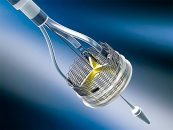Silent stroke is common after transcatheter aortic valve replacement (TAVR). Co-morbidities such as diabetes or chronic renal failure, as well as procedural factors such as pre-dilation, increase the risk of silent stroke. While many events of silent stroke have an early effect on cognition, it is necessary to learn whether the impairment is sustained over…
High Deployment: Also Trending with Balloon Expandable Valves
Conventional implantation of balloon expandable SAPIEN-3 results in a final 70:30 or 80:20 ratio of the valve in the aorta/left ventricular outflow tract. This comes with permanent pacemaker implantation rates of approximately 10%. Higher deployment might translate into lower rates of conduction abnormalities and pacemaker implantation. The study compared a cohort of 1028 consecutive patients; 406…
Cusp Overlap for Higher CoreValve Implantation
Implant depth greater than the length of the membranous septum is an independent predictor of permanent pacemaker implantation. Valve implantation 3 to 5 mm below the aortic annulus in a projection coaxial to the device is recommended. The problem is this is rarely in the annular plane of the valve. Ideal annular plane projection is…
AAS vs Warfarin in Low Risk TAVR
We are still discussing the adequate antithrombotic scheme after transcatheter aortic valve replacement (TAVR). Additionally, we are treating a much wider array of patients ranging from low risk to inoperable. And there is yet one more important point: hypo-attenuated leaflet thickening diagnosed by CT. We are still unaware of the impact they have on device…
Coronary Access After TAVR: A Potential Problem Ahead
Coronary cannulation after transcatheter aortic valve replacement (TAVR) was unsuccessful in almost 10% of patients. This problem occurred almost exclusively in those who received a self-expanding valve. This study, recently published in JACC Cardiovasc Interv., was sought to investigate the feasibility of coronary ostia access after TAVR and describe potential predictors of coronary access impairment.…
Should We Discontinue Anticoagulation Before TAVR?
Against what common sense dictates, continuing oral anticoagulation pre- and post- transcatheter aortic valve replacement (TAVR) is safe, according to this article soon to be published in JACC Interventions. There was no increase in hemorrhagic or vascular complications and, paradoxically, those who continued using anticoagulant agents received fewer transfusions that those who did not. A…
Transfusion in TAVR: Caution Is Best
Periprocedural red blood cell transfusion in transcatheter aortic valve replacement (TAVR) correlates with increased mortality and acute kidney injury. It also resulted an independent predictor of 30-day mortality, irrespective of bleeding and vascular complications. The global trend that limits transfusion, in all procedures in general, has finally reached TAVR. The multicenter registry TRITAVI (Transfusion Requirements…
ProGlide vs. Prostar XL to Close Post-TAVR Access
Minimalist transcatheter aortic valve replacement (TAVR) is a strategy that is here to stay. We have previously published papers comparing local vs. general anesthesia, use of transthoracic vs. transesophageal echocardiography, and early discharge in TAVR. In all these papers, the “minimalist approach” included percutaneous closure of vascular access. However, few papers compare closure devices in…
Sapien Valve Keeps Delivering in Jobs for Which It Was Not Designed
We recently published the success of balloon-expandable Sapien valve when used as mitral valve replacement. We now hear about its success as pulmonary valve replacement. Previous experiences with this prosthesis for aortic valve replacement have encouraged many operators to attempt fixing other valves. At first, there were exceptional cases considered compassionate treatments. However, experience has…
Boston Scientific Discontinues Lotus Valve and Makes a New Bet
Mechanically-expanding valve Lotus Edge was discontinued worldwide, as recently informed by its manufacturer, Boston Scientific. This is a voluntary recall of all Lotus valve inventory, and the immediate suspension of the program. The United States Food and Drug Administration (FDA) approved Lotus Edge in 2019 for patients with severe aortic stenosis and high surgical risk.…








